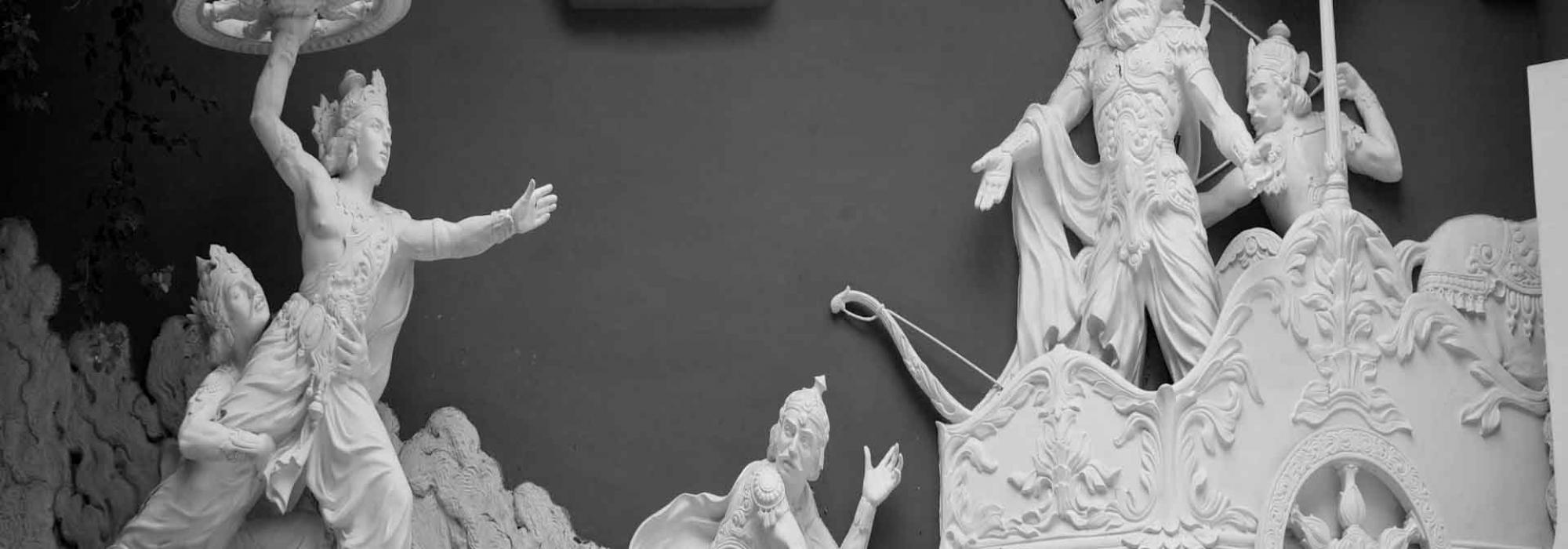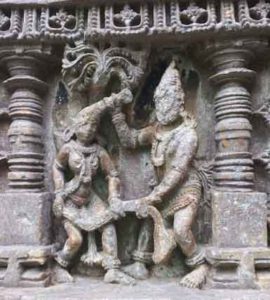To analyse and explore the roots of life, the nature of truth and evil and to probe into human relations, Dr. SL Bhyrappa makes use of myths, legends, rituals and rites in his novels. This gives him ample scope to comprehend contemporary life against the backdrop of the past, and to interpret the past from the contemporary view point. Myths related to natural phenomena such as rain, the spring season, rivers, floods, mountains, cataracts and eclipses are effectively used in ‘Vamshavruksha’, ‘Jalapatha’, ‘Grahana’, ‘Parva’ and other works. Mythological stories of Vasistha and Arundhati and Harischandra and Chandramati throw light on the deterioration of values in the novels ‘Daatu’ and ‘Tantu’ respectively. Various types of legends powerfully convey the ideas and motifs of the works and emphasise the author’s intentions. ‘Saakshi’, by recreating the world of Yama and installing dead human spirits there, establishes a connection between this world and the world after death, and tries to probe into the mysteries and dark secrets of the human psyche. It presents Manjayya as an archetypal evil being, given to licentious sex, and Lakku as the destructive power of evil. Unhealthy and extreme lust for money is presented. ‘Nele’ presents the myth of the world after death through ‘Garudapurana’, and searches for the roots of life, sex and death. ‘Anchu’ evokes the feeling that nature is a companion to man in his joy and sorrow. The Chamundi Hills work as a counsellor, a therapist to Amrutha’s troubled psyche, and saves her from committing suicide. Even the short story ‘Gatajanma’ that Bhyrappa wrote in his adolescence, exposes the convention that girls had to be married off before they attained sexual maturity. If this was not possible, she had to be taken to the forest by the father and left there. Myths and legends are woven meaningfully and artistically in Bhyrappa’s works.
Demystification in Parva
Whereas Bhyrappa has made use of many myths and legends in his novels, in his epic novel ‘Parva’ he has completely divested ‘Mahabharatha’ of its mythical and divine aura. Myths never die. They go on acquiring new patterns, new meanings, new forms in art and literature and create new awareness in the psyche of generations with the passage of time. They may retain their original form, or they may improve or deteriorate and get distorted, but they remain a part of the collective consciousness. Sometimes, it may be difficult to accept the changed forms and sometimes the changed forms may be more acceptable, depending on the norms of a particular period. It is a well-known fact that several Greek myths are employed in different forms in modern literature, as today’s writers assert that an integrative mythology, whether invented or inherited, is essential to literature. James Joyce in ‘Ulysses’ and Patrick O’ Neill in ‘Finnegan’s Wake’ have deliberately woven their modern stories along the pattern of ancient myths. Though there is nothing of the mythological hero Ulysses in James Joyce’s novel, it comprises a single day in the life of a modern man, structured as in the epic struggle and with the immensity of the mythical hero. From the microcosm of a single day in the of life of a single man, James Joyce visualises the pattern of the macrocosm of the mythical hero’s life. The myth of Sisyphus is used by the absurdists and the existentialists to concretise the meaninglessness in the daily activities of life. W.B. Yeats has expounded his own mythology - a systematic mythology - in ‘A Vision’, ‘The second coming’, and ‘Byzantium’. Many of these writers use myths as a pattern for measuring the anarchy, confusion and degeneracy of the present. But these writers do not use the original myth as is. They use only a part of the idea or some specific part of the original myth.
Bhyrappa retains the characters, incidents and the time span of the ‘Mahabharata’. Yet, he demystifies the incidents, characters and the texture of the epic and imbues in them human feelings and weaknesses, and divests them of their superhuman and divine quality. His mythopoeic sensibilities and cosmic consciousness extend their vision to the distant past, and capture it through the lens of the present. In this way, he colours the characters with their emotions, passions, weaknesses and strengths. Thus, he makes them dearer and nearer to us, transforming them into the most modern, yet ancient and universal beings. Bhima, Bhishma, Arjuna, Duryodhana and other characters are more human than stern ‘heroes’. Krishna is wonderfully human, a fine statesman and a diplomat with foresight. He does not reveal his ‘Vishwaroopa’ to Arjuna, but like a modern psychotherapist, counsels Arjuna and assists him in coming out of the confusion and chaos inside his mind. Ganga is not a woman of heaven. The mystery of ‘Niyoga’ is ‘solved’ for ever. Shukamuni’s death, his father’s lamentation, Bhishma’s dilemma, the majesty of his end, Kamsa’s birth and the cause of his cruelty, Hiranyavathi’s story, Sālakaṭaṅkaṭī (or Hidimbi), Gandhari regaining her eyesight, Draupadi relying on her own courage when dragged into Duryodhana’s court: there is not a single character or incident that has not been moulded in the giant furnace of the divine and titanic imagination of this genius called Bhyrappa.
The whole of the ‘Mahabharata’ is recreated and restructured, and through this recreation and restructuring, ‘Parva’ creates its own myth. The incidents and the characters of ‘Parva’ make us think that whatever is described in ‘Parva’ must indeed be true. Through this conviction of the characters therein, ‘Parva’ elevates itself to the status of a myth. Any writing of the calibre of ‘Parva’ is destined to achieve this. This can be attributed to the popularity and a respectful, albeit reluctant appreciation of and an equal measure of aversion to ‘Parva.’. All the characters in Parva surpass the standards of common humanity and shine in their human yet super-human aura. They are like us, yet different from us.
Through this process of restructuring and recreating the ‘Mahabharata’ completely, ‘Parva’ acquires the status of a myth, and Bhyrappa emerges as the new mythmaker because the process itself demands courage, conviction, creative genius and a mind that probes into the abysses of all other minds, which are essential for mythologizing. If other novels of Bhyrappa create social myths, ‘Parva’ establishes ‘Mahabharata’ as a new form of myth.
It is said that myths deal with universal problems of epic proportions, and that they are the cumulative legacy of an ancient religious worldview. What Bhyrappa offers us through the use of myths, legends and rituals in his works is a vision of the cultural heritage of the past and the positive values it had inculcated, along with their present degeneration in our country.
Some opinions of Northrop Frye about Myth and Fiction that are worth pondering [paraphrased by the current author]
……. Modern writers like Eliot, Yeats, James Joyce, O’Neill and others have deliberately woven their modern materials on the pattern of ancient myths. Thus, there is defusable relation between myth and fiction, and this use of myth finally results in the reconstructing of the same mythical patterns in more ordinary words and relevant to the contemporary situation." This, a kind of indirect mythologizing is "Displacement" according to Northrop Frye.
……The concept of myth runs through all the areas of contemporary thought, like sociology, religion, anthropology, psychology, literature and literary criticism..... Since Homer’s time, myth has always been an integral element of literature.....
…….. We have creation myths, fall and flood myths, metamorphosis and dying-god-myths, fertility myth etc. Myths are not historical, but they provide a kind of continuity of tradition. Thus they obliterate the boundaries separating legend, historical reminiscences and actual history.....
……. When a system of myth loses its connection with belief it becomes a purely literary myth. Thus myth provides the main outline and the circumference of a verbal universe, which is later occupied by literature. In all cultures mythology merges insensibly into and with literature. (We may cite the example of ‘The Ramayana’ and ‘The Mahabharatha’ which are mythologies as well as literature proper)
…….. the structural principles of a mythology, built up from analogy and identity, become in due course, the structural principles of literature
mythology and literature occupy the same verbal space, so to speak, the framework or context of every work of literature can be found in mythology as well, when its literary tradition is understood. It is relatively easy to see the place of a myth in a mythology, and one of the main uses of myth criticism is to enable us to understand the corresponding place that a work of literature has in the context of literature as a whole….
Bibliography:
- All novels of S. L.Bhyrappa
- A Glossary of literary terms (M.H. Abrams)
- The Golden Bough (James. G. Frazer)
- From Ritual to Romance (Jessie L. Weston)
- Quest for Myth (Richard Chose)
- Anatomy of Criticism (Northrop Frye)
- Literature and Myth ed. James Thorpe
- Myth, Fiction, and Displacement (Northrop Frye)
Thanks to the edits by Sandeep Balakrishna and Hari Ravikumar














































